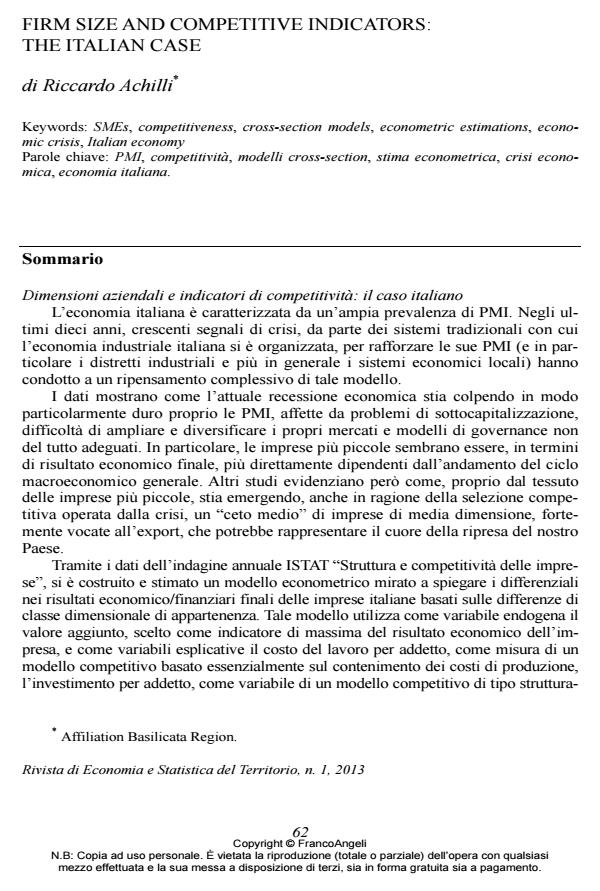Firm size and competitive indicators: the Italian case
Journal title RIVISTA DI ECONOMIA E STATISTICA DEL TERRITORIO
Author/s Riccardo Achilli
Publishing Year 2013 Issue 2013/1 Language Italian
Pages 17 P. 62-78 File size 649 KB
DOI 10.3280/REST2013-001003
DOI is like a bar code for intellectual property: to have more infomation
click here
Below, you can see the article first page
If you want to buy this article in PDF format, you can do it, following the instructions to buy download credits

FrancoAngeli is member of Publishers International Linking Association, Inc (PILA), a not-for-profit association which run the CrossRef service enabling links to and from online scholarly content.
The aim of this article is to analyse the different competitive factors of Italian firms, based on their size-differences, in order to identify the specific elements of the competitive advantages of micro firms, medium firms and big firms, that can help the industrial policy to use more size-specific and selective tools for each size of firm. The aim is to identify consistent correlations between firm dimension, productive sector and competitiveness indicators (specifically, value-added, turnover, labour cost, investments, productivity, profit share on value-added, % of export value on turnover) in order to determine the competitive advantage of firm dimension in each productive sector (using ATECO sectorial classification). Methods and Results The article is based on an econometric analysis, using a cross- section sectorial and dimensional approach, in the period 203-2008, for Italian firms. The enquiry "Structure and competitiveness of industrial and services firm system", of Italian statistical agency (ISTAT) has been used as data base. The economic results of firms, summarized by the value added, have been correlated to some explanatory variable, as the cost of labour per employee, the investment per employee, the labour productivity, the share of turnover coming from exports. The results show a radical difference in the competitive models of firms, according to their size class. While micro firms rely mainly on the control of production costs, and show a difficulty in investing and diversifying their final markets (and those firms are also under a growing competitive pressure on their internal market), medium firms have a strong competitive root in their ability to export. Big companies are reacting to the crisis increasing the ratio between capital and labour, and pushing towards a higher integration in the global markets. Conclusions The competitive models are highly diversified according to the firm size. While the competitive model of micro firms is somewhat traditional and, assuming a "passive position" in the globalisation processes, seems to be inadequate to the challenges of the present macroeconomic cycle, medium and big companies are pushing towards a higher integration in the commercial global processes, and in a higher share of capital/labour ratio, which is indicative (especially for the bigger firms) of a competitive model based on innovation, quality and product/market diversification. Those considerations give room to a more "size-specific" industrial policy. For instance, measures aimed at facilitating credit supply (like public guarantee funds) should be addressed to small firms, while attention should be focused on a better correlation between labour cost and firm’s economic results (stimulating, for example, the participation of workers to big companies capital) in the case of big enterprises.
Keywords: SMEs, competitiveness, cross-section models, econometric estimations, economic crisis, Italian economy
Jel codes: C31, D22, D24, L2, L5, L6, L7
- ANCE (2010), Rapporto 2010 sulla presenza delle imprese di costruzione italiane nel mondo, available at http://www.ance.it/ance/jsp/infoportale/assemblea/pdf/ Estero2010/RAPPORTO2010.pdf.
- Becattini G. (1979), Dal settore industriale al distretto industriale: alcune considerazioni sull’unità di indagine dell’economia industriale, Bari: Economia e Commercio, 1-2.
- Bellandi M. (1998), Capacità innovativa diffusa e sistemi locali di imprese. In: Becattini G., Modelli locali di sviluppo, Bologna: Il Mulino
- Brusco S. (2008), I distretti industriali: lezioni per lo sviluppo, Bologna: Il Mulino
- Centro Studi Confindustria (2008), Cambiare per crescere. le performance dell’Italia nel contesto internazionale, Roma: S.I.P.I.
- Fuà G. (1983), Industrializzazione senza fratture, Bologna: Il Mulino
- Istituto nazionale di statistica (2010), Indagine sulla struttura e competitività delle Imprese, available at http://www.istat.it/salastampa/comunicati/in_calendario /compimp/20101027_00/.
- Iuzzolino G. (2009), Le agglomerazioni territoriali di imprese nell’industria italiana. In: Signorini L., Omiccioli M., Lo sviluppo locale. Un’indagine della Banca d’Italia sui distretti industriali, Roma: Donzelli
- Johnston J. (1989), Econometrica, Milano: FrancoAngeli
- OBI-SRM (2010), Rapporto 2010 impresa e competitività, Napoli: Giannini
- Pavitt K. (1984), Sectoral Patterns of Technical Change. Towards a Taxonomy and a Theory, Research Policy, 9
- Porter M.E. (1998), The Competitive Advantage of Nations, New York: Free Press.
- Savioli G. (2008), Principi contabili internazionali e Basilea 2. L’impatto sulle PMI, Milano: FrancoAngeli
- Schumacher E.F. (1973), Small Is Beautiful: Economics As If People Mattered, Blond And Briggs
- Unioncamere-Istituto Tagliacarne (2007), Le piccole e medie imprese nell’economia italiana, Milano: FrancoAngeli
Riccardo Achilli, Firm size and competitive indicators: the Italian case in "RIVISTA DI ECONOMIA E STATISTICA DEL TERRITORIO" 1/2013, pp 62-78, DOI: 10.3280/REST2013-001003